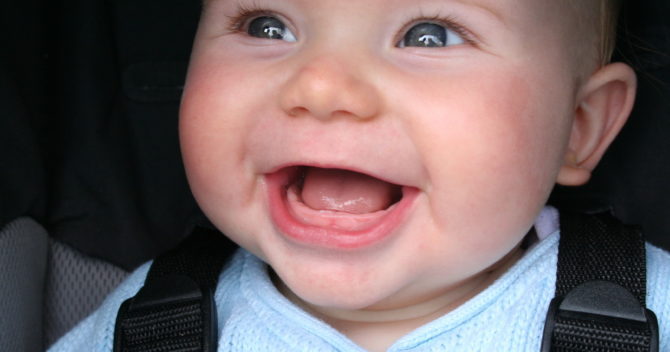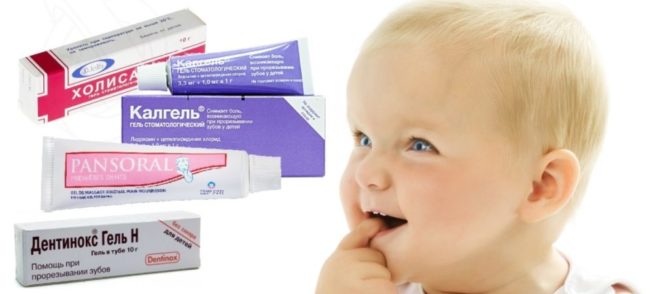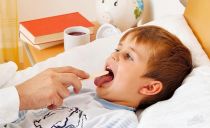Teeth are cut in a child: how and what to anesthetize
The first year of a newborn’s life is the most costly for his parents. The child’s body is actively developing, adapting to the surrounding world - and all this happens not without difficulties. Especially in those moments when the first teeth begin to appear.
If the baby’s gums hurt due to the fact that his teeth are being cut, you can anesthetize them with an anesthetic gel or another drug intended for this. About what means help eliminate discomfort during teething, and will be discussed in the article.
Content
How to understand that a child’s teeth are being cut
The first teeth erupt at the age of 4-8 months. But the timing of teething, as well as the behavior of babies during this period, may vary. The process is partly affected by genetics. To find out if a teething pain awaits a child, it is worth asking his grandparents how their children were doing.
In newborns, the rudiments of milk teeth are already laid. They just wait in the wings to cut through.
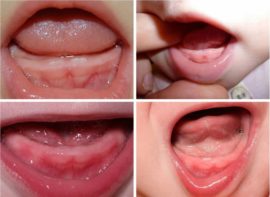 When the first milk tooth appears in a newborn, a whole complex of symptoms is observed. But far from always restless behavior and moodiness are the result of this painful phenomenon. It is worth looking at the behavior of the child. The following signs indicate that he will soon get out his teeth:
When the first milk tooth appears in a newborn, a whole complex of symptoms is observed. But far from always restless behavior and moodiness are the result of this painful phenomenon. It is worth looking at the behavior of the child. The following signs indicate that he will soon get out his teeth:
- the child behaves uneasily more often than usual;
- the baby often cries, sleeps poorly;
- its gums swell and blush;
- the baby jumps in temperature;
- the baby pulls in his mouth all objects falling under his arm;
- he produces a large amount of saliva;
- the baby often wakes up in the middle of the night;
- he has a poor appetite;
- the child touches the ears and face with his hands;
- due to excessive salivation, the child begins to cough;
- hematomas form on its gums.
How to relieve teething pain in children
Teething is accompanied by severe discomfort: the child often cries, refuses the food offered to him, cannot fall asleep. Few people are able to indifferently look at the suffering of the baby, but this is not necessary - the pain during teething can be relieved.
There are three ways to facilitate teething in infants:
- the use of teethers bought in the departments of children's goods or made at home;
- the use of pharmacy drugs: tablets, creams, ointments, gels, suppositories;
- the use of traditional medicine recipes.
Teethers, pharmacy and home-made
The stores present a wide variety of teethers of various shapes and sizes. They can be made of latex, rubber, silicone, plastic and wood. Some of them are equipped with holes for laying painkillers in the form of gels that can be cooled in the refrigerator.
 To facilitate the process of teething in infants, not only specialized tools, but also homemade ones help. Instead of a teether, you can use any cold object: a teaspoon, a frozen banana, an apple or a carrot. A piece of gauze soaked in chamomile infusion and chilled in the refrigerator helps relieve swelling of the gums and reduce pain.
To facilitate the process of teething in infants, not only specialized tools, but also homemade ones help. Instead of a teether, you can use any cold object: a teaspoon, a frozen banana, an apple or a carrot. A piece of gauze soaked in chamomile infusion and chilled in the refrigerator helps relieve swelling of the gums and reduce pain.
An ordinary massage can help teeth to penetrate faster through the gum and relieve pain, which can be carried out both with a silicone brush purchased in a pharmacy and with a clean finger.
Do not give your child frozen fruit directly from the freezer. It is necessary to warm them up a bit, otherwise they will cause frostbite of the gums.
Medical methods for relieving toothache
All medications to facilitate the process of teething in children, which can be bought in pharmacies in Moscow, are divided into three types:
- local analgesics: ointments and gels;
- syrups and candles;
- homeopathic medicines for teething in babies.
Before using medicines designed to relieve teething pain in children, you should consult your pediatric dentist. Make sure that the child’s teeth are actually being cut, because any of the many internal and infectious diseases could be the cause of fever and restless behavior.
Local analgesics: gels and ointments
In any pharmacy you can find gels and ointments that are applied to the gums and have a painkiller effect. Many local anesthetics not only relieve pain, but also kill bacteria.
The most popular medications used for teething in babies include Kalgel, Denthol and Kamistad. The effect of the gels is observed in just a few minutes, but quickly passes. The most prolonged period of exposure is famous for Holisal (up to 2-3 hours).
Varieties of gels
The gels with which you can anesthetize the gums during teething in children are divided into several categories:
- Antiseptics that stop inflammation. With their help, disinfect the oral cavity and destroy bacteria. Such formulations should not be applied to the child’s gums more often than six times a day.
- Anesthetics. The main component of such drugs is an anesthetic, for example, lidocaine hydrochloride. Usually the effect occurs a minute after applying the gel.
- Homeopathic remedies. They include only natural ingredients (plant extracts).
How to use the gel
When using analgesic gels for teething, you must adhere to the following rules:
- the tool should be used only with severe discomfort;
- the gel should be applied to the gums every 3 hours, but no more than 5 times a day;
- a small amount of gel is sufficient to achieve the result;
- Before applying the product on the gums of the baby, you need to thoroughly wash your hands with soap;
- to apply the drug should use a cotton pad;
- the effect of the medicine will increase if gum massage is done during its application.
Before using anesthetic gel, you should read the instructions. Such drugs may have age restrictions; many of them are contraindicated in newborns.
Parent Dental Gels
The following is a list of the most popular gels in the field of dentistry to combat the unpleasant sensations that occur when children climb teeth:
- Calgel. The active ingredients are lidocaine hydrochloride and chamomile flower extract. Chamomile neutralizes inflammation, lidocaine has an analgesic effect. The drug is gently rubbed on the gum in the place where the tooth climbs, not more than 3 times a day. You can use it only after reaching 5 months. The main advantage of Calgel is its quick effect: almost immediately after application.
- Denthol. It has a pleasant fruity aroma. The main ingredient that performs the function of anesthetic is benzocaine. The drug can be used from 4 months of age, when the child begins to crawl out the first teeth. It is also effective in treating stomatitis and minor burns on the oral mucosa.
- Kamistad. The basis of Kamistad is lidocaine and pharmacy chamomile flower extract.Lidocaine quickly anesthetizes the gums, and chamomile reduces inflammation and accelerates tissue regeneration. The drug is applied to the painful area three times a day. Kamistad is categorically contraindicated in children with injuries on the oral mucosa.
- Dentinox. The gel is based on fructose, does not contain sugar. It quickly reduces pain, eliminates the inflammatory process and eliminates signs of gum irritation in the place where new teeth came out. The drug should not be applied to the gum if it is damaged.
- Holisal. Gel with analgesic effect, used in dentistry to reduce inflammation and pain. The tool can be used before eating, so that the baby does not hurt to eat, or at night.
Local anesthetics, in which lidocaine is present, it is better not to apply to the gums of infants before feeding. They can provoke numbness of the mouth, as a result, the child will not be able to swallow food or bite his tongue.
All drugs that facilitate the process of teething in children cause an excessive flow of saliva.
Teething syrups and suppositories
To eliminate the heat and alleviate the condition of a child whose gums hurt due to teething, rectal suppositories can be used. They are easy to use and quickly reduce temperature. In addition to candles, it is permissible to give the child baby syrups and tablets.
The list of the best candles, tablets and syrups used for teething includes:
- Rectal homeopathic suppositories Vibrukol, with a mild antipyretic effect. They can be used from a very early age, since they are devoid of contraindications and gently affect the body.
- Panadol in the form of suppositories, suspensions or tablets. It has an antipyretic property and relieves pain. The main active ingredient of this drug used for teething is paracetamol, which often provokes nausea and swelling of the gums.
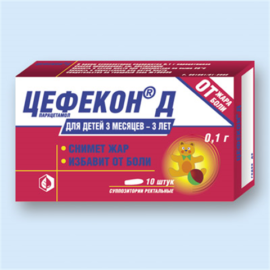 Children's Nurofen containing ibuprofen has the same properties as Panadol. This is a non-steroidal drug used for inflammation of various etiologies. It relieves fever during teething, and also reduces gum disease, helps make the pain almost imperceptible. The suspension has a syrupy consistency and a pleasant strawberry or orange smell.
Children's Nurofen containing ibuprofen has the same properties as Panadol. This is a non-steroidal drug used for inflammation of various etiologies. It relieves fever during teething, and also reduces gum disease, helps make the pain almost imperceptible. The suspension has a syrupy consistency and a pleasant strawberry or orange smell.- Cefecon D suppositories, which are often prescribed for those children who do not want to drink medicine. The main component of the drug that provides analgesia for teething is paracetamol. The medicine effectively relieves fever, has a mild analgesic and anti-inflammatory effect.
Homeopathic remedies
Teething in young children can be facilitated with the help of homeopathy. Such drugs stop inflammation and reduce pain. Their main advantage is the absence of contraindications, with the exception of allergic reactions to individual ingredients. Homeopathic remedies can be used as often as necessary.
The list of the best homeopathic medicines for gum pain relief includes:
- Baby Doctor "First Teeth." The active components of the medicine are calendula, marshmallow root, chamomile, echinacea and plantain.
- Homeopathic ointment Traumeel. A significant minus of this product of homeopathy is that it is not recommended for the relief of teething pain in children under 3 years of age due to the lack of clinical trial data.
- Drops Dantinorm Baby from the French company Boiron. Made from chamomile, indian ivy and rhubarb. This homeopathic remedy is given to children during teething 2-3 times a day for 3 days. Thanks to the dosed plastic containers, you can not be afraid to give the baby a larger amount of the drug than necessary.
What painkillers can be done at home
Many parents use folk remedies to relieve pain during teething in infants. To calm a baby who has a teething toothache, you can give her a drink of herbal tea or an infusion of a mixture of chamomile, lemon balm, lavender and catnip. To prepare the medicine, take a tablespoon of herbal collection, pour a glass of boiling water and let the mixture brew for 15-30 minutes. After that, give her baby two teaspoons.
Toothache can be relieved by rubbing tinctures of valerian, burdock root and stellate root, a mixture of clove and almond oil (in a 2 to 1 ratio), a composition of honey and soda (one teaspoon each) diluted in a glass of water.
Toothache helps to remove amber beads. You need to put them on the neck of the newborn, but do not forget about safety: the baby can easily get confused in the decoration.
How to behave with a baby whose teeth are cut
When trying to help a baby whose teeth are being cut, do not forget about your own mood. Children acutely feel the indignation and excitement of their parents. Better show the maximum possible care and patience, because during this period the baby needs special support. Try to distract him from the discomfort of games and bright objects.
Do not lubricate the baby's gums with alcohol-containing painkillers and give him an antipyretic based on aspirin. If the baby refuses food, cool it to a cool state so that it gives him less discomfort.

